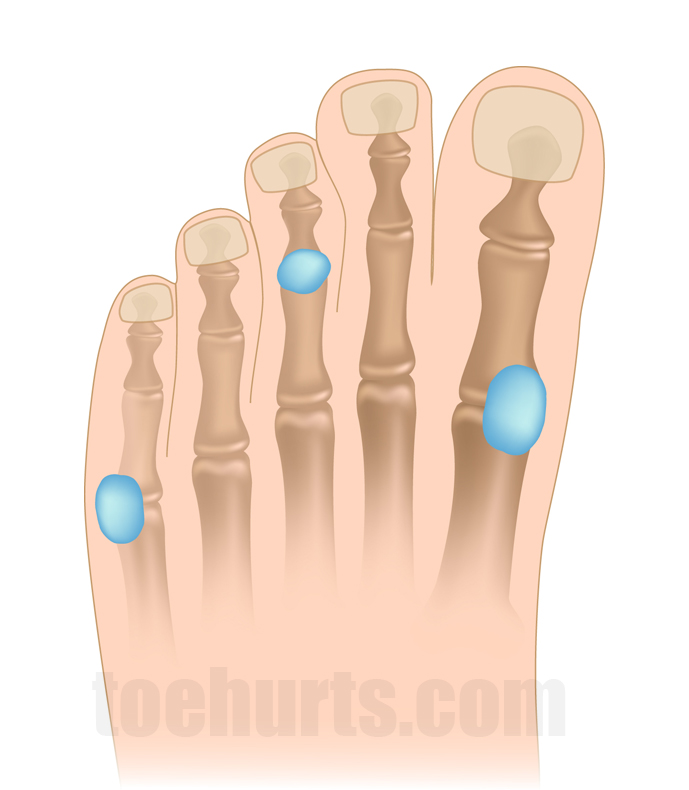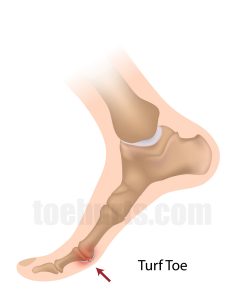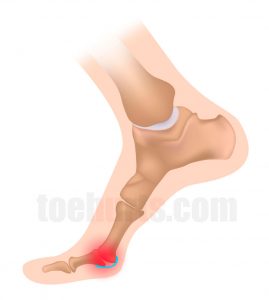Bursitis
Bursitis is a condition that many people around the world struggle with at some point in their lives and is well known for causing considerable pain and discomfort, especially when walking. It can occur at various points across the foot, with the area around the toe joints, the sides of the foot, and the heel and ankle areas particularly susceptible. It’s completely normal for a small number of bursae to be present in the foot and toe (and various other parts of the body), but when excessive pressure and friction are applied, the body produces bursae in abnormal quantities, resulting in the development of bursitis. Other parts of the body that are commonly affected by bursitis include the elbows, the hips, and the shoulders. The knees are also sometimes affected by bursitis, but it’s not as common. These areas all have something in common; they are joints that are heavily used, often to perform repetitive actions.
Toe Bursitis Causes
There are four known causes of toe bursitis, which are:
- Direct Toe Blow or Injury – While injuries such as muscle tears don’t usually result in symptoms of bursitis, should you suffer a particularly bad direct blow to your body, this could potentially cause a bursa to become inflamed. However, this will usually heal without any serious form of treatment required.
- Repetitive Toe Strain – If a particular joint is put under abnormal amounts of pressure through repetitive use, the strain placed on the joint can lead to bursitis. Bursitis can often develop as a consequence of your occupation, with “housemaid’s knee” and “miner’s elbow” being just a couple of the nicknames that have been assigned to bursitis over the years.
- Diseases Affecting the Toe Joints – There are many progressive diseases that affect the joints, such as rheumatoid arthritis and gout, which can cause bursae to swell. There are also numerous calcium-crystal diseases that can result in crystals being formed inside the bursa sacs themselves, which at the least causes significant friction and irritation. In more severe cases, these crystals may actually rip these sacs.
- Infections – There are many common bacterial infections that can cause the bursae to become inflamed.
Symptoms of Toe Bursitis
How do you know whether you have bursitis? While there may be other indications of bursitis, the following signs are the most common:
- The affected area will most likely be visibly swollen and the skin will be an “angry” red.
- This toe may also be sensitive to the touch.
- You may feel an aching or stiff sensation in your toe.
- Skin that feels hot, and burning sensations are also relatively common.
How Can You Prevent Toe Bursitis?
Prevention is always better than the cure! The use of shoe supports and specially designed footwear can be particularly useful in this sense. The goal should be to minimize the amount of friction between your foot and the shoes you wear. If blisters do start to form, this is a good sign that you need to make a change, otherwise, a bursa may form and lead to the onset of bursitis.
Toe Bursitis Treatment
If you are diagnosed with toe bursitis, a doctor will typically recommend a range of “conservative treatments.” These include things like specially designed padding, straps, and orthotic devices. In the vast majority of cases (over 90% in our experience), these treatments are able to improve the patient’s condition or resolve it altogether.
Toe Bursitis Self-Help Treatments
Many times it’s possible to improve the condition of bursitis at home in just a few days by utilizing some basic treatments. Considerable improvements are often noted in 5 days, and it will usually clear up completely in just a couple of weeks. These treatments include:
- Rest. This might sound obvious, but it plays a vital role in helping your body to heal. Take the weight off your feet and rest as much as you possibly can. If you do have to be up and about on your feet, the use of a specially designed sling, splint or padding will help to reduce the pressure placed on your foot. Strenuous exercise is out of the question!
- Anti-Inflammatory Medication. Simple anti-inflammatory medications that are available over the counter(these include aspirin, ibuprofen, and naproxen) will not only provide pain relief, but they can help to reduce the amount of swelling in the affected area too. You could take Acetaminophen too, but please be aware that while this will help to take the pain away, it won’t have any effect on the swelling.
- Ice-Heat Treatment. Initially (for 2 or 3 days), you should apply ice to the area of your foot that is affected, as this will help to bring the swelling down. In the days that follow, replace the ice with a heating pad or bathe your foot in warm water, as this will not only provide pain relief, but it will improve circulation to the affected area (this is essential to the healing process!).
- Physiotherapy. Physio (as it’s often referred to) is a health treatment that is proven to have a positive impact on bursitis. Not only will it help to strengthen joint muscles, but it also helps to improve blood flow and remove waste products from the affected area.
Using a combination of these treatments will likely produce a positive outcome. One other thing to note is that liniments and balms are a waste of time (and money) when it comes to bursitis, as they aren’t able to penetrate the skin and treat the real problem.


